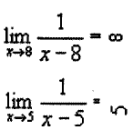|
mewse posted:Hell no. What do you gain by looping faster than 60 Hz on an LCD? Not that I'm necessarily advocating it, but constantly looping does not mean that you are rendering in every iteration of the game loop. You usually have limits for lots of things -- how often physics are updated, how often sound locations are updated, how often you render, etc. Each component may be updated at different rates. Believe it or not, many games really do just eat up the CPU like this and that doesn't mean they are trying to render 1000 frames per second.
|
|
|
|

|
| # ? May 25, 2024 19:07 |
|
That Turkey Story posted:Not that I'm necessarily advocating it, but constantly looping does not mean that you are rendering in every iteration of the game loop. You usually have limits for lots of things -- how often physics are updated, how often sound locations are updated, how often you render, etc. Each component may be updated at different rates. Believe it or not, many games really do just eat up the CPU like this and that doesn't mean they are trying to render 1000 frames per second. I realize game loops can be decoupled from screen refresh. What do you gain by your game loop going faster than 60 Hz.
|
|
|
|
Every professional game engine I've worked with has utilized 100% CPU. There were only very rare cases where you were intentionally sleeping the main thread. xgalaxy fucked around with this message at 04:42 on Apr 5, 2012 |
|
|
|
mewse posted:I realize game loops can be decoupled from screen refresh. What do you gain by your game loop going faster than 60 Hz. You may wish for other components to go faster, for instance, physics or even just game logic.
|
|
|
|
That Turkey Story posted:You may wish for other components to go faster, for instance, physics or even just game logic. For zero benefit
|
|
|
|
mewse posted:For zero benefit No, not really. Just because you don't see the effects of things like physics every frame doesn't mean that they are not important. For example, depending on how often you update physics and how you interpolate movement can mean the difference between whether you are able to jump up onto a given platform or not.
|
|
|
|
mewse posted:For zero benefit You could get benefit out of running portions of a planning AI at 100%, or streaming resources in and out of memory, or running threads or pseudothreads doing things like updating shadow maps or geometry that don't happen every frame, but get benefit out of going on asap.
|
|
|
|
For clarification. If the game isn't threaded or whatever, then obviously you would only be utilizing that one core. So on a dual core, for example this would show up as 50% CPU usage. And then, if you are using multiple cores, then how effectively you are distributing work load across them will determine whatever spikes and slumps in CPU percent utilized. I guess I just don't see a compelling reason to purposely sleep the main thread, especially when sleep, on windows in particular, is notoriously inaccurate and is not guaranteed to sleep for the length requested -- usually it takes longer. So when you have very specific Hz budgets for rendering, physics, etc, relying on sleep is a very bad idea.
|
|
|
|
That Turkey Story posted:No, not really. Just because you don't see the effects of things like physics every frame doesn't mean that they are not important. For example, depending on how often you update physics and how you interpolate movement can mean the difference between whether you are able to jump up onto a given platform or not. So you want a faster game loop so the player CAN jump on the platform, or so that they CAN'T jump on the platform? Doom 3 capped at 60 Hz because players were deliberately setting the Q3A tick rate at a certain breakpoint to jump higher. Unormal posted:You could get benefit out of running portions of a planning AI at 100%, or streaming resources in and out of memory, or running threads or pseudothreads doing things like updating shadow maps or geometry that don't happen every frame, but get benefit out of going on asap. This actually does make sense since it's variable processing time features that you can throw the CPU at. Eating up the CPU because you think "faster game loop = better" is stupid
|
|
|
|
Quake, doom, etc. cap simulation at 60hz. Theyre still running the main loop. Just because you're capping at whatever Hz doesn't mean you stop looping, ever. And drat straight they're trying to render as fast as possible.
|
|
|
|
mewse posted:This actually does make sense since it's variable processing time features that you can throw the CPU at. Eating up the CPU because you think "faster game loop = better" is stupid Especially if you have the game paused but still open. That drives me nuts. If I want to go check an FAQ while I'm gaming, I expect the game to all but halt while I do so.
|
|
|
|
It is pretty typical, even for games that are balls-out when running, to watch window state and yield a bunch of CPU when minimized.
|
|
|
|
Unormal posted:It is pretty typical, even for games that are balls-out when running, to watch window state and yield a bunch of CPU when minimized. Yes, exactly. Nothing wrong with that, and pretty common.
|
|
|
|
Thanks for all the feedback. It's good to know that I'm in the right direction, but a bit scary that this is considered the right direction.  OneEightHundred posted:100% CPU usage in a real-time game is not exactly a problem, your game will chew up every ounce of CPU it has available unless it (or something it calls) tells the OS that it doesn't need the CPU for a while or until something happens. Delay is not a "hack," it's one of the "I don't need this CPU" mechanisms and a process that doesn't take long to do things between delays will take up negligible amounts of CPU. Alternately, use event responses and timers from the windowing API instead and don't even have a main loop. Locked framerate is another choice, though I enjoy watching the FPS counter reach thousands.  OneEightHundred posted:Re: Resource management, that's a classic case of an application-specific answer. The goal of resource management is three-fold: I've had a possibly-smarter resource management idea for a while, but I can't figure out if it's any good or not until I put it in practice, which will be a long time since making the game part of the game takes priority. Kelson posted:I vehemently disagree, as would most professional For example, OpenXcom needs to be a 2D 8-bit low-res game that reproduces the look and feel of an old DOS game and handles non-standard resource formats and etc. Where are you gonna find an engine that covers all that? I got SDL to keep me company and that's about it. xgalaxy posted:I don't get the CPU thing.  (I see their point but I can't make Game A work like Game B or Game C just because they want it to, even if the whole goal of OpenXcom is to make Game A work like Game B). mewse posted:Hell no. What do you gain by looping faster than 60 Hz on an LCD? SupSuper fucked around with this message at 13:18 on Apr 5, 2012 |
|
|
|
xgalaxy posted:I guess I just don't see a compelling reason to purposely sleep the main thread, especially when sleep, on windows in particular, is notoriously inaccurate and is not guaranteed to sleep for the length requested -- usually it takes longer. So when you have very specific Hz budgets for rendering, physics, etc, relying on sleep is a very bad idea. I'm not sure 'inaccurate' is the right way to put it. The windows clock is only accurate to a certain number of milliseconds, depending on platform - 15.6 is a common number, but the definition of what a tick is can vary even across windows platform. And the definition of sleep on win32 is more along the lines of "block the thread for x millseconds" - after that, the thread is put in the ready state, but it's up to the OS when it's actually going to resume. If you have to do something extremely sensitive/time-based using the win32 api, you're better off using queryperformancecounter if you just need to get the time - but queryperformancecounter doesn't have a notification mechanism, so it isn't straightforward to use it as a timer, so you should be using a multimedia timer for that. This generalizes to other platforms in that it's a really good idea to figure out what the timer resolution and other idiosyncrasies of threading are going to be, otherwise if you dealing with a problem where something got 4 milliseconds slower and it's screwing performance (user complains the scrolling got slower! 10 million dollar contract at risk), you're going to have problems. A sleep is never a good solution to a problem - it might work, but you're always better off if you do the research to figure out how to understand when something is supposed to kick in, rather than waiting for a arbitrary amount of time.
|
|
|
|
SupSuper posted:Again, the problem here is my game isn't some simple level-based affair where I can easily guess what resources will be required in the future, and just taking the opposite approach of loading-stuff-as-needed is probably just as bad. I think that, generally, the best strategy is to stream in what you think you'll need soon, give priority to things you need immediately (and possibly wait on it), and put everything not in the relevant set into an elimination queue which you can use to eliminate resources as you run out of room.
|
|
|
|
You can also do what the unreal engine does and keep the lowest detail mip map of textures always around to use as temporaries while you load the full rez ones. Same with lowest lod of models, but you can't really do that with animations. This is all assuming your game is completely random with no way to guess what resources you might need intelligently.
|
|
|
|
Quick question: Does Flixel/Stencyl do parallaxing for 2D platformers?
|
|
|
Rupert Buttermilk posted:Quick question: Does Flixel/Stencyl do parallaxing for 2D platformers? Sure, to a degree. Stencyl makes parallax scrolling fairly easy, as long as you have pre-rendered backgrounds to work with. All you need do, in that case, is load the backgrounds, arrange their z-order, and set their scroll speed percentages. However, Stencyl does not provide a way to use multiple tilemap layers in a parallax scrolling scheme. There is a parallax behavior on the Forge, but I don't know anything about it.
|
|
|
|
|
Centripetal Horse posted:Sure, to a degree. Stencyl makes parallax scrolling fairly easy, as long as you have pre-rendered backgrounds to work with. All you need do, in that case, is load the backgrounds, arrange their z-order, and set their scroll speed percentages.
|
|
|
|
Are there any papers or GDC talks on security in a Freemium game? I'm starting to think about ways of authenticating/validating unlocks/purchases but would like to read/watch anything that's already public...
|
|
|
|
Most freemium games run the actual game on hosted servers in which case it's as trivial as requiring a registered account to play and only allowing unlocked items to be used. Games run on private servers (i.e. TF2, BF Heroes) generally rely on servers being compliant and doing the same thing, but have to concede modded servers being able to get around it eventually and the most you can do is delist them. Authentication usually just use a client-server public key encryption scheme and password hashing. Basically: - Client generates a random symmetric (i.e. AES, Blowfish) encryption key - Client encrypts the key using a public key encryption algorithm (i.e. ECC, RSA) - Client sends that encrypted key to the server as part of the initial handshake - Server decrypts the key using its private key and all further communication occurs under the symmetric cipher - Client sends password hash (i.e. SHA2) to the server - Server compares the password hash against the hash in its database - If it matches, great, user is considered logged in OneEightHundred fucked around with this message at 19:47 on Apr 5, 2012 |
|
|
Shalinor posted:Doesn't DAME somehow handle the multiple parallaxing tile layers? I'm pretty sure it lets you create any number of tile-based layers with independent parallax, and I thought you could dump basically any DAME level directly into Flixel? I geared my response toward Stencyl more than Flixel. Stencyl uses Flixel, but there are several levels between Stencyl and Flixel, which sometimes makes it difficult to dump raw code into the right place. I have not tried a DAME map with Stencyl, but it might work.
|
|
|
|
|
OneEightHundred posted:Most freemium games run the actual game on hosted servers in which case it's as trivial as requiring a registered account to play and only allowing unlocked items to be used. I haven't played Battlefield Heroes yet, but what I mean specifically is what is the security around the generation of Valor Points on a private server? What's to stop me from running a private server and reporting the generation of Valor points through completing missions? Or to have a script running 24/7 that every 60 minutes I gained 60 valor points or whatever the expected 'average' amount of points per unit of time is? If there's a reward for doing a specific mission, what's to stop someone from saying they did that mission on a private server, etc... My concern is when not playing on a hosted server a player claims to have gotten an unlock that could normally cost a micropayment but is also available through player action (Completing a challenge/mission, spending xp/Valor points/Unlock points, etc...) and hacking that message instead of doing the actually earning.
|
|
|
|
I don't know about BF Heroes, but BF Bad Company 2 is set up so that you don't earn any xp unless there are (I think) at least six people on the server, to keep you and your buddy from easily grinding unlocks.
|
|
|
|
Rupert Buttermilk posted:Quick question: Does Flixel/Stencyl do parallaxing for 2D platformers? Look for the scrollFactor property on FlxObject. Just set that to progressively smaller numbers (between 0 and 1) for each layer behind the foreground.
|
|
|
|
Hughlander posted:Are there any papers or GDC talks on security in a Freemium game? I'm starting to think about ways of authenticating/validating unlocks/purchases but would like to read/watch anything that's already public... Its highly platform specific question too =) For iOS as an example, a common mistake is to store unlocks/puchases/etc in UserDefaults. This is bad, because its essentially a plain text file. Store that stuff in the keychain!
|
|
|
|
If you dominate CPU usage with a tight loop in a Java application, there's a decent chance you'll miss keypress/keyrelease/mouse events.
|
|
|
|
|
h_double posted:I don't know about BF Heroes, but BF Bad Company 2 is set up so that you don't earn any xp unless there are (I think) at least six people on the server, to keep you and your buddy from easily grinding unlocks. Also, long delays between ban waves make it much harder for hackers to tell how they're being detected, not just because of the smaller sample size, but also because it increases the number of things that could have caused a detection on a given account and makes it much harder to single one factor out. OneEightHundred fucked around with this message at 00:46 on Apr 6, 2012 |
|
|
|
Rupert Buttermilk posted:Quick question: Does Flixel/Stencyl do parallaxing for 2D platformers? I'm pretty sure it does. Here's an example game that uses it: http://jayisgames.com/games/psychopomps/ It's kind of a small indie title though, so you've probably never heard of it.
|
|
|
|
Pfhreak posted:I'm pretty sure it does. Here's an example game that uses it: http://jayisgames.com/games/psychopomps/ poo poo, man, I was JUST ABOUT to post 'Dude... what...?" Then I kept reading, and reading is power!  Anyway, dude, you wanna work together this year again?
|
|
|
|
So is this a thread for sparsly posting what we're currently working on as well? I don't have much to show right now but I wouldn't mind having a place to show as I go along so people can maybe tell me what is poo poo/good or comment on. If this isn't the place for that then sorry, I'll stop! Never wrote a game before much more than the odd little app on Android so making my first steps into a roguelike in Java (Black spots under the walls and the wall pieces aren't all sized properly - I'm aware of these but I'm more concerned with moving ahead with the framework of the application before getting into the art... which is tough because it's what I'm most excited about.)  The dungeon randomizer is working and working fast, I diagrammed how I'm going to deal with entities and game structure so I'm just getting that all in place right now. The randomizer can also create caves and rooms with bedrooms and different cool things but it's not perfect yet so I don't have it turned on. Next in line: -Add entities, including a controllable character piece. -Implement less robotic and more realistic non-player entity path-finding as well as direct path-finding for the player. -Only display/render visible tiles from player entity perspective tiles. -Begin dungeon Stairs/Non-player entity and "loot" generator/placer. Mewse posted:"I like, I can't even... gently caress. Programming, I can't even like... these loving compilers, they don't even loving work. I am never going to do that poo poo." -Mewse, 2012
|
|
|
|
Hmm... K, I am sorta stumped on how to begin something here. Mostly the storage of the data. If I have a world map that's divided into territories - picture a state map divided into counties, say - and I want to highlight a particular county when the mouse is hovering over it, how would I store the "shape" of the county? I'm using XNA - does it have some sort of open-ended-number-of-sides polygon? I haven't noticed one anywhere. I figure I could store like a List<Vector2> or something, but for map-style shapes that seems like it could get pretty complex. What I'm shooting for is a map editor where you can load in a flat terrain image, and then "draw" the territory shapes on it, which it will then save out to some machine-readable map format, or even just XML describing each territory. So...thoughts?
|
|
|
|
Harvey Mantaco posted:The dungeon randomizer is working and working fast, I diagrammed how I'm going to deal with entities and game structure so I'm just getting that all in place right now. The randomizer can also create caves and rooms with bedrooms and different cool things but it's not perfect yet so I don't have it turned on. Ah, what the hell. I'll use this as an excuse to post my (apparently incredibly similar) project I've been working on, as well.     This is the isometric roguelike-ish thing I've been working on since January. Ignore the graphics--I'm just either doing 2-minute scrawls or stealing sprites off the internet as placeholders until I'm confident that I'm not going to be changing my tile size or anything like that--, but this is more or less how I'm planning for it to work. I say that it's roguelike-ish because it's actually going to be a team game (where you control one guy during exploration and place the rest of the team whenever you enter combat), and the emphasis will be more on smaller lairs that you visit multiple times than big dungeons that you just head down in and never turn back till you hit the bottom. Also ignore the arbitrary distribution of kitchens, since that's what I'm working on currently. Harvey Mantaco, how are you doing map-generation (if you're willing to spill design secrets)? You look really good (I am super jealous of your walls), but even for a way-dungeony map the complete lack of halls/non-rectangular rooms is throwing me a little. By 'rooms with bedrooms' did you mean more fancily shaped rooms on a layout level or just the types of items that will decorate the room?
|
|
|
|
OtspIII posted:Harvey Mantaco, how are you doing map-generation (if you're willing to spill design secrets)? You look really good (I am super jealous of your walls), but even for a way-dungeony map the complete lack of halls/non-rectangular rooms is throwing me a little. By 'rooms with bedrooms' did you mean more fancily shaped rooms on a layout level or just the types of items that will decorate the room? You're jealous? I'm jealous  I'll let you know my general algorithm. I wanted long hallways with no interruptions to be really sparse. 1. Create a random room with a basic shape, either randomized rectangle, cave, circle, shaped like a skull... whatever. I got a few. 2. Chance of now adding an inner section to the room. So a room inside of the room for example, or a sleeping quarters against a wall with beds in it and such... lots of different things. 3. Once the room is created place it on the "main" map. The first room will go in a random place, every room after that basically has the world generator play a game of Tetris to stick it in a close fitting and available location for a moment. Changing the buffer of how close rooms will be to each other will create a greater chance of longer hallways in the next step. 4. When the room is placed I run an algorithm to find random and reasonable locations for doors on a random side of the room. Once a door is placed a corridor shoots off from the room until it finds another room and if it does it connects and draws the hallway. If no connections are found after X tries then keep track of the failure to place and create another room to try again. If >3 connections are made OR we reach our counter and at least one has been made then finalize the room and place it and go onto the next one. Enough failures and we don't need to draw any more doors, the "main" map is full. Obviously there is more but that's pretty much it. It's fast and I like how I can basically add any kind of new room or whatever to it and nothing breaks. Once everything is placed I quickly run through the Array[][] of rooms and it looks at each wall. That wall looks at it's surrounding walls to decide what kind of wall it should be (a wall to the left and right? I'll be a horizontal wall! A wall above and the right? I'll be an L shaped pointing up and right!) I'm in the same boat with you, I'm not worried about graphics right now until basically the very end of this (never ending goddamn) project. When I saw your little goblin dudes I smiled, then I saw the one with the crown and I literally laughed out loud. I don't know, caught me off guard. Harvey Mantaco fucked around with this message at 23:17 on Apr 6, 2012 |
|
|
|
HaB posted:Hmm... I'm not familiar with XNA, so I don't know if it has a built-in solution to this type of problem. I can tell you how you deal with this sort of problem in the general case. You want a list of countries, where each country contains:
In JSON it might look something like this: code:When the user moves the mouse, you test to see if the mouse coordinates are within the bounding box of the country's polygon. If they are, then you perform the more expensive Point in Polygon calculation above to see if the mouse coordinates are actually within the country's polygon. If you have a large number of countries, you can also build a spacial index (e.g., a Quadtree) to cut down on the number of bounding box comparisons. You don't even need something as elaborate as a Quadtree; a simple 10x10 grid will probably be sufficient for a list of non-overlapping countries. So, when the mouse position changes:
That should be enough to get you started. I used the technique above to solve a similar problem for a work-related GIS tool. Edit: fixed JSON quotes.
|
|
|
|
An alternate option would be to assume that every clickable pixel only belongs to a single country. (A fair assumption as otherwise what's the response logic when they click on e.g. the exact meeting points of Luxembourg, France and Germany.) Define your country boundaries with bounding polygons as already specified but then use that to build up an invisible "bitmap" where each "pixel" contains, not a colour, but an index/identifier of the associated country. Thus determining the country you're hovering above is very fast: just a memory lookup. Highlighting the territory underneath the cursor can then be done with the original polygonal bounds, or if you're feeling old school a simple flood fill. (Naturally, this is only necessary when the underlying country has changed.) Of course, this solution is inappropriate if your map is continuously scalable or extremely large relative to the target device's memory capacity.
|
|
|
|
Harvey Mantaco posted:I'll let you know my general algorithm. Oh, nice. I came close to doing it somewhat similarly, but I realized I actually did want a lot of hallways and control over the sort of over-flow of the dungeon. Also, the way I tried to do it was pretty inelegant and looked really bad. My process got a little windy, but it still generates a big map in less than a second so I'm not worrying about it yet (although I'm sure it'll slow the gently caress down once I start populating rooms with a bit more detail). 1. I divide my level into 4 and assign each a pre-drawn pathway grid. Each of those 4 sections is made up of a 3x3 grid of sections of its own, each of which track if they connect to each of their neighbors or not. This results in an overall 6x6 pathway-grid that goes through the whole level but feels fairly randomized (examples below). I do this so that I can artificially make sure there are some choke points and some remote areas in the map, while leaving the map's center fairly maze-like and interconnected. If there are other levels on the same depth or levels below it stairs or more hallways will get spawned, too.  2. I have a list of geomorphs that I then place in each of the open slots in the 6x6 grid. It makes sure that the chosen geomorph has an exit in every direction that the underlying pathway map desires, and rejects any that don't. I actually ended up making the geomorphs themselves pretty flexible, too, so that most of them actually have optional hallways baked into them--if they are supposed to link to the geomorph to their east they grow a hall to the east, and if not that part of the geomorph is just blank. There's also a bit of randomness baked into them, so that many of the rooms only appear 1/3 of the time or so on, so that people can't just memorize the geomorph shapes and know what's coming up on them. It came out way better than I could have dreamed for--the example I posted above only actually uses 6 geomorphs to populate itself, despite having 34 open slots. 3. I run an audit on the map and let each room know who its neighbors are, how far it is from the dungeon entrance, etc. The idea is that the further you get from the entrance/the shortest path you can take towards the downward staircase, the less traffic there is in the dungeon and the odds of running into monsters goes down, while the odds of running into traps and unlooted treasure goes up. 4. Using the data from the audit I figure out what every room I've placed should be, based on its size, remoteness, the ratio between its height and width, etc. I start by placing monster lairs, then once I've put one team of monsters in the dungeon for every 4 rooms I assign a theme to any room that hasn't already had a theme assigned to it. The 'themes' are the stuff I posted above like 'kitchen' or 'profane temple' or 'goblin throne room'. These spawn things the room's decorations and will probably determine the type of treasure that appears if the room is tagged to contain a treasure hoard (I haven't gotten that far yet). I'm leaving out a few steps (each dungeon is actually built off of a core set of rumors about it that determines what type of monsters live in it, what its big treasure-hoards look like, etc), but that's more or less it. Your room placement method sounds really good, based on all the things I'm trying to make sure I worry about. The rooms seem to have a good balance of both branchyness and loopyness, and even though the screenshot you posted is pure rectangles, they do have a really nice variety of sizes and shapes. I'm obsessively hunting for other similar projects I can steal ideas from, so I'm looking forward to seeing you post more updates here in this thread.
|
|
|
|
HaB posted:Hmm... A typical data structure for planar subdivisions (e.g. maps) is a doubly connected edge list. DCEL is similar to what MrPablo was describing, except it adds some extra information which is useful for building search structures. ynohtna's solution isn't bad, if you don't need a lot of accuracy. MrPablo's would be okay, if your country boundaries aren't very detailed. If your map is very detailed, you should read up on trapezoidal maps. If you don't want to do any preprocessing at all, beyond the bare minimum for rendering the map, you can usually get good results with a random walk on the Delaunay triangulation.
|
|
|
|

|
| # ? May 25, 2024 19:07 |
|
Null Pointer posted:As MrPablo stated, you are trying to solve the point location problem. A good answer to this question will depend on the size and complexity of your map (and the amount of work you're willing to do.) You could do a BSP (like a doom level) to divide the map into convex hulls then you could check each hull's sides to pick the hull where you're on the 'inside' of every edge. Never solved this problem before, just what popped to mind. A 'bitmap' with country codes instead of colors is certainly the easiest if you're not memory-constrained though.
|
|
|




























